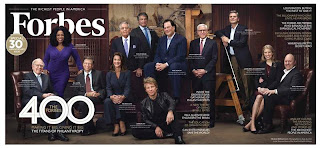The World Has A Growing Inequality Problem And The U.S. Is No Different
The "Great Recession" officially ended three years ago in the second half of 2009. The unemployment rate is down from its double-digit peak in October 2009. The Wall Street investor class is dancing for joy because the Dow Jones Industrial Average has doubled in value since its recent low in March 2009. With home prices, sales, and construction up, the housing market seems to be recovering quite well.
The American economy appears to be on the rebound, but, not everyone is benefitting because America has a growing inequality problem that has many Americans staring either into the economic abyss or watching over their shoulder for a pink slip as they live paycheck-to-paycheck.
Inequality is a global problem. Let me start with the world first and then work my way back to America.
In a new report, The Cost of Inequality: How Wealth and Income Extremes Hurt us All, a leading international philanthropy organization, Oxfam, argues that inequality caused by extreme concentrations of wealth and income is economically damaging and inefficient, harmful to human progress, undermines efforts to end poverty, environmentally destructive, and may fuel civil unrest and political instability.
How bad is it? Oxfam research shows that growing wealth and income inequality is a global problem. There are roughly 1200 billionaires in the world. In 2012, the top 100 billionaires increased their wealth by $240 billion, enough to end world poverty four times over. Almost half the world's population could live just off the net worth of the world's 250 richest people.
In the U.S., since 1980, the richest 1 percent has doubled their share of national income, rising from 10 percent to 20 percent. For the uber-rich (0.01 percent), their share of income quadrupled to levels never seen before. The richest five Americans made almost $7 billion each last year (if you are counting in your head, that's $3,500,000.00 per hour) just from their investments. If the top 400 wealthiest Americans pooled their investment profits from last year, they could pay the in-state tuition and fees for every college student in the U.S.
According to data released late last year by the U.S. Census Bureau, 46.2 million people (15 percent) lived in poverty – an annual income of $22,811 for a family of four with two children – which was about the same percent from the year before.
While the number of people living in poverty stayed about the same, the number of families struggling with poverty despite parents working for a living increased during the same period. A growing number of Americans returned to work after the Great Recession, but mostly to low-wage, service-sector jobs, not the middle-class jobs they held before the boys and girls on Wall Street and the U.S. financial sector nearly ruined the nation's economy with their reckless profiteering.
According to a new report by The Working Poor Project, a privately funded nation-wide initiative aiming to develop policies that assist low-income families achieve economic security, the ranks of the working poor is growing. The number of working families struggling to survive on low-wages – defined as below 200 percent of the official poverty threshold – increased from 10.2 million in 2010 to 10.4 million in 2011. Their data show that in 2011, the total number of individuals living in low-income working families was 47.5 million. The number of children living in low-income working families stood at 23.5 million.
These low-wage jobs – about one in four adults in low-income working families held jobs in just eight occupations, as cashiers, cooks, health aids, janitors, maids, retail salespersons, waiters and waitresses, or drivers – "typically offer limited opportunities for advancement, few (if any) benefits, and create challenges for parents trying to balance work and family responsibilities."
In 2011, the 20 percent of working families that sit at the top the social structure hauled in an impressive 10.1 times the total income of the bottom 20 percent of working families, up from a formerly impressive 9.5 percent in 2007. Now, sit down if you are reading this while standing. To put another way, the richest one-fifth of working families took home 48 percent of all income, while the bottom one-fifth of working families took home less than 5 percent of all income.
If it wasn't for the nation's social safety net, poverty and inequality would be even worse. Specifically, in 2011, if it wasn't for Social Security an additional 21.4 million people (including 14.5 million seniors) would have slid into poverty. In 2011, if it wasn't for unemployment insurance, 2.3 million people would have slid into poverty. In 2011, the earned income tax credit and child tax credit kept 5.7 million working people out of poverty. In 2011, the Supplemental Nutrition Assistance Program kept 3.9 million people out of poverty.
A rising tide does not lift all boats. America cannot end poverty unless we strengthen (not weaken) our social safety, create greater economic opportunities for struggling working families and, most importantly, do something about inequality to close the gap between the rich and the poor. A permanent class of uber-rich Americans is dangerous for democracy.



Comments